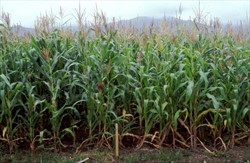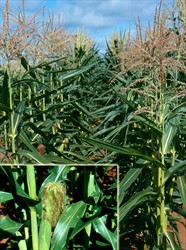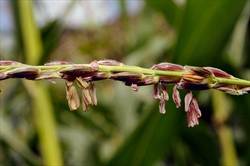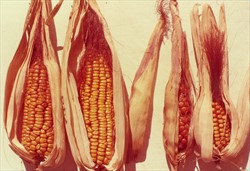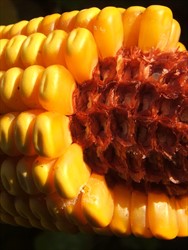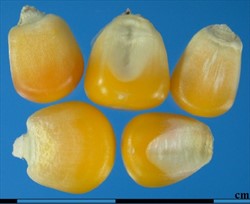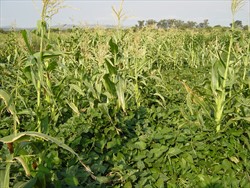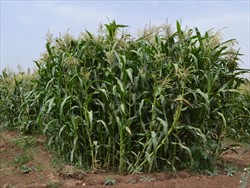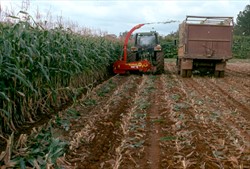Tropical Forages
Zea mays L.
Subordinate taxa:
Zea mays L. subsp. mays
Note: This fact sheet refers only to the cultivated subspecies, ssp. mays. The other three subspecies, subsp. huehuetenangensis (H.H. Iltis & Doebley) Doebley, subsp. mexicana (Schrad.) H.H. Iltis and subsp. parviglumis H.H. Iltis & Doebley, are wild types commonly knows as "teosinte".
subsp. mays: Zea amylacea Sturtev.; Zea curagua Molina; Zea indentata Sturtev.; Zea indurata Sturtev.; Zea japonica Van Houtte; Zea mays group ceratina Kuleshov; Zea mays subsp. amylacea (Sturtev.) Zhuk.; Zea mays var. alba Alef.; Zea mays var. flavorubra Körn.; Zea mays var. indentata (Sturtev.) L.H. Bailey; Zea mays var. indurata (Sturtev.) L.H. Bailey: Zea mays var. japonica (Van Houtte) Alph. Wood; Zea mays var. leucodon Alef.; Zea mays var. saccharata (Sturtev.) L.H. Bailey; Zea mays var. tunicata Larrañaga ex A. St.-Hil.; Zea mays var. vulgata Körn.; Zea saccharata Sturtev.
Family: Poaceae (alt. Gramineae) subfamily: Panicoideae tribe: Andropogoneae subtribe: Tripsacinae.
An erect, fast growing, short-lived annual growing to 7 m, but more commonly to 2–3 m in height; usually with a single main culm and one or occasionally 2 lateral branches in the leaf axils in the upper part of the plant. Internodes cylindrical in the upper part, alternately grooved on the lower part with a bud in the groove. Leaves alternate with broad, sword-shaped leaf blades, parallel veins with a prominent mid-rib, and small ligules. Upper surface is hairy, lower surface hairless. The main culm produces at least 8 leaves, with temperate hybrids producing an average of 15 leaves and tropical hybrids producing up to 48 leaves. Conventional roots are supplemented with aerial brace roots, which protect against lodging. Flowers monoecious, born in separate parts of the plant. Female flowers (ears) arise from axillary bud apices. Male flowers (tassels) arise from the apical stem. Ears consist of a robust rachis (cob), with 4–30 rows of almost sessile spikelets bearing the caryopses (kernels). Kernels are highly variable, producing a range of commercial types including dent, flint, flour, waxy, pop and sweet corn. 2,500–4,400 seeds per kg.
Africa: mielie (Afrikaans); mealie (Southern Africa); العربية dura shami, ذرة ḏurah (Arabic); agbado (Yoruba), oka (Igbo), masara (Hausa) (Nigeria); maheende (Central Africa); mahindi, mase (Northern Africa)
Asia: pôot (Cambodia); 玉蜀黍, 中文 yu shu shu (China); 日本語 tō-morokoshi (Japan); 한국어 gangnaengi, ogsusu (Korea); khauz ph'ôd; khauz sali (Laos); jagung (Malaysia and Indonesia); ข้าวโพด khao-phot (Thailand); ngô, bắp, bẹ (Vietnam)
English: corn, dent corn, field corn, flint corn, maize, pod corn, popcorn, sweet corn
Europe: maïs, blé d'Inde (French); Mais, Welschkorn (German); granoturco, mais comune (Italy); milho (Portuguese); maiz (Spanish); majs (Swedish)
Indian subcontinent: मक्का makka मकई makai, भुट्टा bhutta (Hindi), চুজাক chujak (Manipuri), भुट्टा bhutta (Marathi), மக்கா சொலம் makka cholam (Tamil), മക്കാ ചൊലമ് makka cholam (Malayalam), mokka javanalu (Telugu), makkejola (Kannada), mako (Konkani), makka مککا (Urdu) (India); makai (Nepal); makki (Pakistan)
Native:
The region of origin is presumed to be the western Sierra Madre in Mexico (Michoacán and Jalisco). Domestication is thought to have occurred 7,000–12,000 years ago. Early forms were very small, with very small kernels. It is possible that very early domestication facilitated the co-evolution of corn in Peru. Substantial genetic manipulation occurred in the 20th Century, predominantly through inbreeding lines for hybrid seed production.
Cultivated:
Cultivated globally in tropical, subtropical and more frequently, in temperate regions.
Forage
As a forage, corn is normally green chopped or made into silage before being fed to animals; however, it can also be directly grazed or conserved as hay. Makes excellent silage due to its high yields and no requirements for additives to assist the ensiling process. Stover from corn grown for grain (dry leaves and stems) is a major source of feed for ruminants. In regions of south-east Asia, older leaves are stripped from the plants while they grow and are fed to ruminants.
Other
Grain used as human feed and for livestock; also fermented to produce ethanol for biofuel.
Soil requirements
Has a high nutrient demand for optimum growth and responds strongly to fertilizer when grown on infertile soils. Adapted to well-drained soils of neutral to mildly alkaline reaction, but will grow down to pH 5.0 providing that aluminium saturation is low. Has low to moderate tolerance of soil salinity.
Moisture
Grows best in 600–1,500 mm annual rainfall environments and has a high requirement for water. Not drought resistant but will tolerate temporary dry conditions when young. Drought-avoiding short season cultivars have been developed for regions with short rainy seasons. There is a direct relationship between yield and rainfall after 5-weeks growth.
Temperature
Requires a soil temperature of 12 ºC or more for satisfactory germination and seedling vigour, but requires higher temperatures (max/min 33/18 °C) for optimum growth. Minimum temperature for growth is 8.7 °C. Frost susceptible. Has been grown over a wide climatic range through domestication and development of cold tolerant cultivars. Grown at altitudes of up to 4,000 m asl in the tropics but prefers <2,400 m asl. Requires increasingly long growing season with increasing altitude.
Light
Requires full sunlight.
Reproductive development
Short day (<12 hours), or neutral day (12–14 hours) plant, normally maturing in 90–120 days, but as quickly as 80 days with very short season cultivars. In the high altitude tropics, may take over 6 months to flower. Maize is a monoecious, wind-pollinated plant. The ovary produces a long style or silk that extends from the cob and receives the pollen from the tassel. Self-pollination is possible, but wind and protandry promote cross-pollination.
Defoliation
Will tolerate defoliation during early growth, but seasonal leaf and grain yields may be reduced where rainy seasons are short. For silage production, should be cut in the medium dough stage when the grain is full. Senescing leaves can be stripped during growth with no apparent impact on yield.
Fire
Intolerant of fire.
Guidelines for establishment and management of sown forages.
Establishment
Requires a well-prepared seed-bed and is often planted into raised beds. Seeding rates vary with cultivar, fertility and rainfall/irrigation, and range from 25,000 to 75,000 plants/ha (4–12 kg seed/ha). Bed/row spacings range from 75 to 120 cm apart and seed is planted 5–10 cm deep depending on soil type and moisture. Precision planting equipment or hand seeding is preferred to achieve a uniform plant stand; broadcast planting is not recommended. Sown in spring through to mid-summer in the subtropics and at the break of the wet season in the tropics.
Fertilizer
Fertilizer is generally applied both pre-plant and as side-dressings to achieve high yields. Maize responds strongly to fertilizer but rates will be dependent upon seasonal soil moisture availability and cultivar selection. NPK fertilizer rates/ha of about 80 kg N, 20 kg P and 30 kg K are commonly used for rain-grown crops. Attention to weed control is essential until canopy closure.
Compatibility (with other species)
Can be planted in combination (interrow cropping) with legumes such as lablab ( Lablab purpureus) and cowpea (Vigna unguiculata). Legume fallows of 1–2 years using Lablab purpureus, Mucuna pruriens, Sesbania sesban, etc. are recommended to improve soil fertility and structure and reduce fertilizer requirements for subsequent maize crops.
Companion species
Generally planted as a monoculture, but can be planted as an intercrop with e.g. pumpkin (Cucurbita spp.), pigeon pea ( Cajanus cajan), cowpea ( Vigna unguiculata), and in hedgerow intercropping systems with hedgerows of Leucaena leucocephala or other shrub legume species.
Pests and diseases
Susceptible to many diseases, including maize smut (Ustilago maydis), head smut (Sphacelotheca reiliana), and various stalk and ear rots such as Gibberella and Diplodia. Plant breeding programs have strongly focussed on disease resistance with considerable success.
Attacked by a wide variety of insect pests including chinch bug (Blissus leucopterus) in the United States, and corn ear worm (Heliothis/Helicoverpa armigera) in Australia. Pesticides are commonly used to achieve control. The maize weevil or greater rice weevil (Sitophilus zeamais Coleoptera: Curculionidae) is a serious pest of stored grain around the world tropics.
Ability to spread
May occur as a volunteer in subsequent crops.
Weed potential
Is reported to be negligible.
Nutritive value
Maize silage is high in metabolisable energy (9–12 MJ/kg DM) but relatively low in crude protein (7–8%). Digestibility of silage can be increased by the addition of urea or molasses. Urea also increases the CP concentration as does intercropping with a compatible legume, whilst molasses improves the water-soluble carbohydrate concentration. Stover contains 3.5–4.0% CP and requires an additional CP source to achieve moderate levels of animal production. Crude protein concentration can be increased to 8–10% through urea treatment or to 10–14% by addition of a high quality legume forage; however, low digestible energy concentrations may also limit growth.
Palatability/acceptability
Highly palatable to ruminants as a green feed, silage or as hay. Silage is palatable without the use of additives.
Toxicity
Lactic acidosis can occur if moderate to large quantities of grain, such as corn, are fed to ruminants not yet adapted to grain diets. Acidosis results from the rapid fermentation of highly digestible carbohydrates, resulting in a dramatic increase in production of lactic acid and a lowering of rumen pH. Mild cases cause dehydration and loss of appetite, whereas serious cases result in acidification of the blood causing heart failure, kidney failure and death. Livestock should be gradually introduced to high-grain diets over a period of 3 weeks to prevent risk of acidosis.
Feedipedia links
https://www.feedipedia.org/node/358 (Green feed)
https://www.feedipedia.org/node/556 (Grain)
Dry matter
As a forage, maize is capable of producing 15–25 t of DM/ha with 10–12 MJ/kg DM of metabolisable energy within a 4‒5 month period if correctly managed. Yield is directly related to days to maturity, so that long duration cultivars (120 days) have a greater yield potential than short duration cultivars (80–90 days), assuming adequate soil moisture over the growing season. Maize grown in the tropics generally produces a larger number of leaves and is generally leafier than temperate grown maize.
Animal production
Animal production from maize silage depends on the quality and amount of the silage fed. At 50% of total DM intake, cattle growth rates of 0.6–1.0 kg/head/day can be expected. Additional digestible protein will further increase liveweight gains.
Cultivated corn and the wild members of diploid and tetraploid Zea can be crossed to produce fertile F1 hybrids. In the wild, introgressive hybridization does not occur because of differences in flowering time, geographic separation, block inheritance, developmental morphology and timing of the reproductive structures, dissemination, and dormancy. Most of today’s high yielding fodder cultivars are hybrid or double-hybrid strains because maize shows especially high heterosis effects. Less than 5% of the genetic diversity within Zea is currently utilised in commercial cultivars. 2n = 20, 21, 22, 24. ‘Leafy’ and ‘stay green’ genes are useful for forage types.
Crops are generally green chopped and fed to stock or the material is cut and ensiled. Maize silage is generally made from the entire plant, which comprises highly digestible components (kernels, pith) and less digestible components (rind, tassel, midrib, stem fibre). Breeders are aiming to increase the percentage of highly digestible components in forage maize.
Primarily developed as a grain crop, grain yields of 8–10 t/ha are commonly achieved from hybrids growing under ideal conditions, but yields of 1–5 t/ha are more common under dryland conditions in the tropics and subtropics (world average 3.6 t/ha). Hybrid cultivars are most commonly grown today and hybrid seed crops require significant isolation distances to avoid pollen contamination. For this reason, hybrid seed crops are not normally produced on smallholder farms, although cooperation among villagers has enabled hybrid seed to be produced in certain regions of China. Dry weather at tasselling can severely affect pollination and grain yields.
Atrazine or simazine at 1.5–2.5 kg/ha can be used for pre-emergent weed control. 2,4–D amine at 0.45–0.55 kg/ha is used post-emergence on crops at least 25 cm high for control of broad-leafed weeds.
- Produces high DM yields over short seasons.
- High metabolisable energy concentration.
- Excellent for silage production.
- Wide range of maturity types are available.
- High soil moisture and fertility requirements.
- Poor acid-soil tolerance.
- Must be replanted annually.
- Hybrid seed to be bought for each crop.
Brewbaker, J.L. (2003) Corn production in the tropics: The Hawaii experience. University of Hawaii at Manoa, Honolulu, HI, USA. hdl.handle.net/10125/25515
Keady, T.W.J., Hanrahan, J.P., Marley, C.L. and Scollan, N.D. (2013) Production and utilization of ensiled forages by beef cattle, dairy cows, pregnant ewes and finishing lambs - A review. Agricultural and Food Science 22(1):70–92. doi.org/10.23986/afsci.6852
Moran, J. (1996) Forage conservation: Making quality silage and hay in Australia. Agmedia, East Melbourne, Australia.
A wide variety of cultivars are available throughout the world and local expertise should be sought to ascertain the appropriate cultivars for specific locations. Dent maize (Zea mays var. indentata) is the main variety grown commercially for grain and fodder. Commercial dent maize cultivars are single, or double-cross hybrids bred for special areas, soils and climatic conditions.
Modern forage cultivars contain ‘stay green’ and ‘leafy’ genes which prolong the vegetative growth, delay tassel and ear initiation and increase leaf number.
Short-season varieties have been developed to produce a crop with only 300 mm of rain.
Not able to be listed – the many maize and forage maize plant improvement programs around the world have emerging new material.
